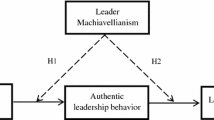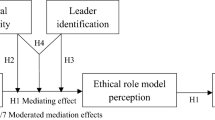Abstract
Thus far, we know much more about the significant outcomes of perceived ethical leadership than we do about its antecedents. In this study, we focus on multiple types of ethical role models as antecedents of perceived ethical leadership. According to social learning theory, role models facilitate the acquisition of moral and other types of behavior. Yet, we do not know whether having had ethical role models influences follower perceptions of one’s ethical leadership and, if so, what kinds of role models are important. We conducted a field study, surveying supervisors and their subordinates to examine the relationship between three types of ethical role models and ethical leadership: the leader’s childhood role models, career mentors, and top managers. We found that having had an ethical role model during the leader’s career was positively related to subordinate-rated ethical leadership. As expected, this effect was moderated by leader age, such that the relationship between career mentoring and ethical leadership was stronger for older leaders. Leader age also moderated the relationship between childhood models and ethical leadership ratings, such that having had childhood ethical role models was more strongly and positively related to ethical leadership for younger leaders. We found no effect for top management ethical role models. Implications for research and practice are discussed.


Similar content being viewed by others
References
Allen, T. D., Eby, L. T., Poteet, M. L., Lentz, E., & Lima, L. (2004). Career benefits associated with mentoring for protégés: A meta-analytic review. Journal of Applied Psychology, 89, 127–136.
Aquino, K., & Reed, A. (2002). The self-importance of moral identity. Journal of Personality and Social Psychology, 83(6), 1423–1440.
Atkins, R., Hart, D., & Donnelly, D. M. (2004). Moral identity development and school attachment. In D. Lapsley & D. Narvaez (Eds.), Morality, self and identity (pp. 65–82). Mahwah, NJ: Erlbaum.
Avolio, B. J. (1999). Full leadership development: Building the vital forces in organizations. Thousand Oaks, CA: Sage Publications.
Bagozzi, R. P., & Yi, Y. (1988). On the evaluation of structural equation models. Academy of Marketing Science Journal, 16(1), 74–94.
Bandura, A. (1977). Social learning theory. Englewood Cliffs, NJ: Prentice Hall.
Bandura, A. (1986). Social foundations of thought and action: A social cognitive theory. Englewood Cliffs, NJ: Prentice-Hall.
Bandura, A. (1991). Social cognitive theory of moral thought and action. In W. M. Kurtines & J. L. Gewirtz (Eds.), Handbook of moral behavior and development (pp. 45–59). Hillsdale, NJ: Lawrence Erlbaum.
Bandura, A., Ross, D., & Ross, S. A. (1963). A comparative test of the status envy, social power, and secondary reinforcement theories of identificatory learning. Journal of Abnormal and Social Psychology, 67, 527–534.
Bass, B. M., Waldman, D. A., Avolio, B. J., & Bebb, M. (1987). Transformational leadership and the falling dominoes effect. Group & Organization Management, 12(1), 73–87.
Berkowitz, M. W., & Grych, J. H. (1998). Fostering goodness: Teaching parents to facilitate children’s moral development. Journal of Moral Education, 27, 371–391.
Brown, M. E., & Mitchell, M. S. (2010). Ethical and unethical leadership: Exploring new avenues for future research. Business Ethics Quarterly, 20(4), 583–616.
Brown, M. E., & Treviño, L. K. (2006). Ethical leadership: A review and future directions. Leadership Quarterly, 17(6), 595–616.
Brown, M. E., Treviño, L. K., & Harrison, D. A. (2005). Ethical leadership: A social learning perspective for construct development and testing. Organizational Behavior and Human Decision Processes, 97(2), 117–134.
Browne, M. W., & Cudeck, R. (1993). Alternative ways of assessing model fit. In K. A. Bollen & J. S. Long (Eds.), Testing structural equation models (pp. 136–162). Thousand Oaks, CA: Sage.
Clinard, M. B. (1983). Corporate ethics and crime: The role of middle management. Beverly Hills, CA: Sage.
Detert, J. R., Treviño, L. K., Burris, E. R., & Andiappan, M. (2007). Managerial modes of influence and counterproductivity in organizations: A longitudinal business-unit-level investigation. Journal of Applied Psychology, 92(4), 993–1005.
Eisenberg, N., & Fabes, R. A. (1998). Prosocial development. In W. Damon & N. Eisenberg (Eds.), Handbook of child psychology (5th ed., pp. 701–778). New York: Wiley.
Ferrell, O. C., & Gresham, L. G. (1985). A contingency framework for understanding ethical decision making in marketing. Journal of Marketing, 49(3), 87–96.
Gibson, D. E. (2003). Developing the professional self-concept: Role model construals in early, middle, and late career stages. Organization Science, 14, 591–610.
Gibson, D. E. (2004). Role models in career development: New directions for theory and research. Journal of Vocational Behavior, 65(1), 134–156.
Gibson, D. E. (2006). Role Models. In J. H. Grennhaus & G. A. Callanan (Eds.), Encyclopedia of career development (pp. 701–703). Thousand Oaks, CA: Sage.
Hansen, S. D., Alge, B. J., Brown, M. E., Jackson, C. L., & Dunford, B. E. (2012). Ethical leadership: Assessing the value of a multifoci social exchange perspective. Journal of Business Ethics. doi:10.1007/s10551-012-1408-1.
Hoffman, M. L. (1980). Moral development in adolescence. In J. Adleson (Ed.), Handbook of adolescent psychology (pp. 295–343). New York: Wiley.
James, L. R., Demaree, R. G., & Wolf, G. (1984). Estimating within-group interrater reliability with and without response bias. Journal of Applied Psychology, 69(1), 85–98.
Jones, J. M. (2011). Retrieved 4 Jan 2012, from http://www.gallup.com/poll/151460/Record-Rate-Honesty-Ethics-Members-Congress-Low.aspx.
Jordan, J., Brown, M. E., Treviño, L. K., & Finkelstein, S. (2013). Someone to look up to: Executive-follower ethical reasoning and perceptions of ethical leadership. Journal of Management, 39(3), 660–683.
Joreskog, K. G., & Sorbom, D. (1993). LISREL ® 8: Structural equation modeling with SIMPLIS™ command language. Chicago: Scientific Software International.
Kacmar, K. M., Bachrach, D. G., Harris, K. J., & Zivnuska, S. (2011). Fostering good citizenship through ethical leadership: Exploring the moderating role of gender and organizational politics. Journal of Applied Psychology, 96(3), 633.
Kalshoven, K., Den Hartog, D. N., & De Hoogh, A. H. B. (2011). Ethical leader behavior and big five factors of personality. Journal of Business Ethics, 100(2), 349–366.
Kanareff, V. T., & Lanzetta, J. T. (1958). The acquisition of imitative and opposition responses under two conditions of instruction-induced set. Journal of Experimental Psychology, 56, 516–528.
Kenny, N. P., Mann, K. V., & MacLeod, H. (2003). Role modeling in physicians’ professional formation: Reconsidering an essential but untapped educational strategy. Academic Medicine, 78(12), 1203–1210.
Kohlberg, L. (1969). State and sequence: The cognitive-development approach to socialization. In D. A. Goslin (Ed.), Handbook of socialization theory and research (pp. 347–480). Chicago: Rand McNally.
Lefkowitz, M., Blake, R. R., & Mouton, J. S. (1955). Status factors in pedestrian violation of traffic signals. Journal of Abnormal and Social Psychology, 51, 704–705.
Lickona, T. (1983). Raising good children. Toronto: Bantam Books.
Lippitt, R., Polansky, N., & Rosen, S. (1952). The dynamics of power. Human Relations, 5, 37–64.
Manz, C. C., & Sims, H. P. (1981). Vicarious learning: The influence of modeling on organizational behavior. Academy of Management Review, 6(1), 105–113.
Mayer, D. M., Aquino, K., Greenbaum, R. L., & Kuenzi, M. (2012). Who displays ethical leadership and why does it matter? An examination of antecedents and consequences of ethical leadership. Academy of Management Journal, 55(1), 151–171.
Mayer, D. M., Kuenzi, M., Greenbaum, R., Bardes, M., & Salvador, R. (2009). How low does ethical leadership flow? Test of a trickle-down model. Organizational Behavior and Human Decision Processes, 108(1), 1–13.
Moberg, D. J. (2000). Role models and moral exemplars: How do employees acquire virtues by observing others? Business Ethics Quarterly, 10(3), 675–696.
Oliner, S. P., & Oliner, P. M. (1988). The altruistic personality: Rescuers of jew in nazi europe. New York: Free Press.
Perry, G., & Nixon, C. (2005). The influence of role models on the negotiation ethics of college students. Journal of Business Ethics, 62, 25–40.
Ragins, B. R., Cotton, J. L., & Miller, J. S. (2000). Marginal mentoring: The effects of type of mentor, quality of relationship, and program design on work and career attitudes. Academy of Management Journal, 43(6), 117–1194.
Rest, J. R. (1986). Moral development: Advances in research and theory. New York: Praeger.
Robinson, S. L., & O’Leary-Kelly, A. M. (1998). Monkey see, monkey do: The influence of work groups on the antisocial behavior of employees. Academy of Management Journal, 41(6), 658–672.
Rosenhan, D. (1970). The natural socialization of altruistic autonomy. In J. Macaulay & L. Berkowtiz (Eds.), Altruism and helping behavior: Social psychological studies of some antecedents and consequences (pp. 251–268). New York: Academic Press.
Rubin, R. S., Dierdorff, E. C., & Brown, M. E. (2010). Do ethical leaders get ahead? Exploring ethical leadership and promotability. Business Ethics Quarterly, 20(2), 215–236.
Schaubroeck, J. M., Hannah, S. T., Avolio, B. J., Kozlowski, S. W. J., Lord, R. G., Treviño, L. K., et al. (2012). Embedding ethical leadership within and across organization levels. Academy of Management Journal, 55(5), 1053–1078.
Sims, R. R., & Brinkmann, J. (2002). Leaders as moral role models: The case of John Gutfreund at Salomon Brothers. Journal of Business Ethics, 35(4), 327–339.
Sizer, T. R., & Sizer, N. F. (1999). The students are watching. Boston: Beacon Press.
Tepper, B. J. (2000). Consequences of abusive supervision. Academy of Management Journal, 43, 178–190.
The Harris Poll. (2011). Retrieved 4 Jan 2012, from http://www.harrisinteractive.com/vault/HI-Harris-Harris-Poll-Confidence-Index-2011-05-18.pdf.
Treviño, L. K. (1986). Ethical decision making in organizations: A person–situation interactionist model. The Academy of Management Review, 11(3), 601–617.
Treviño, L. K. (1990). A cultural perspective on changing and developing organizational ethics. In R. Woodman & W. Passmore (Eds.), Research in organizational change and development (pp. 195–230). Greenwich, CT: JAI Press.
Treviño, L. K., Brown, M. E., & Hartman, L. P. (2003). A qualitative investigation of perceived executive ethical leadership: Perceptions from inside and outside the executive suite. Human Relations, 56(1), 5–37.
Treviño, L. K., Hartman, L. P., & Brown, M. (2000). Moral person and moral manager: How executives develop a reputation for ethical leadership. California Management Review, 42(4), 128–142.
Treviño, L. K., & Youngblood, S. A. (1990). Bad apples in bad barrels: A causal analysis of ethical decision-making behavior. Journal of Applied Psychology, 75(4), 378–385.
Walumbwa, F. O., Mayer, D. M., Wang, P., Wang, H., Workman, K., & Christensen, A. L. (2011). Linking ethical leadership to employee performance: The roles of leader–member exchange, self-efficacy, and organizational identification. Organizational Behavior and Human Decision Processes, 115(2), 204–213.
Walumbwa, F. O., & Schaubroeck, J. (2009). Leader personality traits and employee voice behavior: Mediating roles of ethical leadership and work group psychological safety. Journal of Applied Psychology, 94(5), 1275–1286.
Weaver, G. R., Treviño, L. K., & Agle, B. (2005). “Somebody I look up to:” Ethical role models in organizations. Organizational Dynamics, 34(4), 313–330.
Weaver, G. R., Treviño, L. K., & Cochran, P. L. (1999a). Corporate ethics programs as control systems: Influences of executive commitment and environmental factors. Academy of Management Journal, 42(1), 41–57.
Weaver, G. R., Treviño, L. K., & Cochran, P. L. (1999b). Integrated and decoupled corporate social performance: Management commitments, external pressures, and corporate ethics practices. Academy of Management Journal, 42(5), 539–552.
Yussen, S. R., & Levy, V. M, Jr. (1975). Effects of warm and neutral models on the attention of observational learners. Journal of Experimental Child Psychology, 20, 66–72.
Zey-Ferrell, M., Weaver, K. M., & Ferrell, O. C. (1979). Predicting unethical behavior among marketing practitioners. Human Relations, 32(7), 557–570.
Author information
Authors and Affiliations
Corresponding author
Rights and permissions
About this article
Cite this article
Brown, M.E., Treviño, L.K. Do Role Models Matter? An Investigation of Role Modeling as an Antecedent of Perceived Ethical Leadership. J Bus Ethics 122, 587–598 (2014). https://doi.org/10.1007/s10551-013-1769-0
Received:
Accepted:
Published:
Issue Date:
DOI: https://doi.org/10.1007/s10551-013-1769-0




